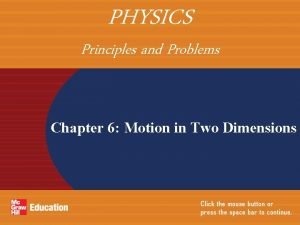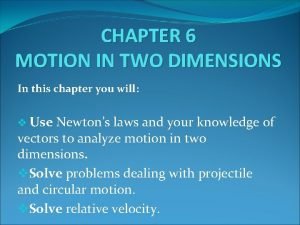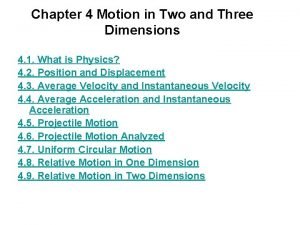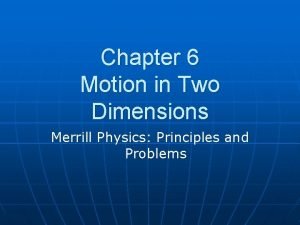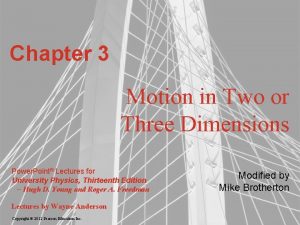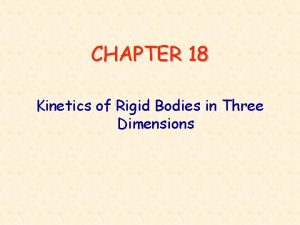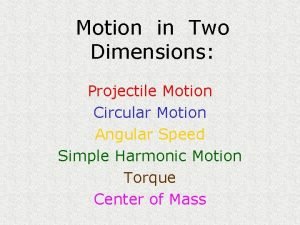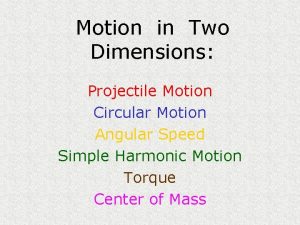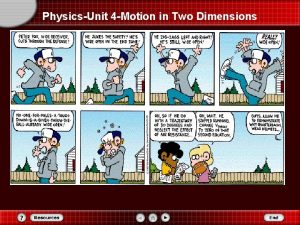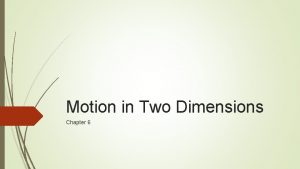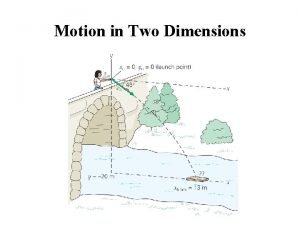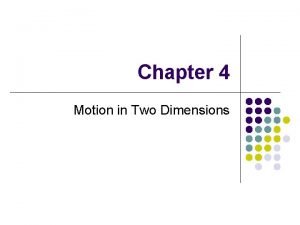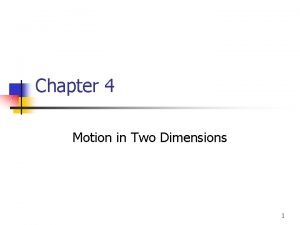Unit 1 Motion in Two Dimensions Motion in



![Resultant Displacement in 2 D � Ex: A cyclist travels 5. 0 km[E], 4. Resultant Displacement in 2 D � Ex: A cyclist travels 5. 0 km[E], 4.](https://slidetodoc.com/presentation_image_h2/9e37083d7ec243195e2c98f2e802ee5b/image-4.jpg)




![Even More Practice �A ball rolling with initial velocity of 40 m/s[W] undergoes an Even More Practice �A ball rolling with initial velocity of 40 m/s[W] undergoes an](https://slidetodoc.com/presentation_image_h2/9e37083d7ec243195e2c98f2e802ee5b/image-9.jpg)
- Slides: 9

Unit 1 Motion in Two Dimensions

Motion in 2 Dimensions � Uniform motion is the simplest motion to analyze, however is not as common as nonuniform motion

Resultant Displacement in 2 D � Ex: a boy walks home from his home 1. 7 km [E], and then 1. 2 km [S] to get to his hockey arena. His total or resultant displacement is shown below: Instead of a vector scale diagram, you can use Pythagorean Theorem & Trigonometric ratios (SOH CAH TOA) to figure out missing sides and angles
![Resultant Displacement in 2 D Ex A cyclist travels 5 0 kmE 4 Resultant Displacement in 2 D � Ex: A cyclist travels 5. 0 km[E], 4.](https://slidetodoc.com/presentation_image_h2/9e37083d7ec243195e2c98f2e802ee5b/image-4.jpg)
Resultant Displacement in 2 D � Ex: A cyclist travels 5. 0 km[E], 4. 0 km[S], and then 8. 0 km[W]. Draw a vector scale diagram to help determine total displacement.

Average Velocity in 2 D � The average velocity in 2 D is total displacement over total time elapsed � Since more than one displacement is involved in 2 D, the resultant displacement (vector) is used to calculate average velocity

Practice � Ex: After leaving the huddle, the receiver of a football team runs 8. 5 m[E] waiting for the ball to be snapped. He then turns abruptly and runs 12. 0 m[S] to receive a pass. He runs 13. 5 m[W] before being tackled. A) Draw a vector scale diagram of the situation

Practice (continued) � B) If the entire motion takes 7. 0 s, determine the receiver’s average velocity. (You will need to find the resultant/total displacement)

More Practice � A student starts at the most western point of a circular track with a circumference of 200 m. She runs all the way around the track in 26. 0 s. A) Determine the student’s average speed. B) Determine the student’s average velocity.
![Even More Practice A ball rolling with initial velocity of 40 msW undergoes an Even More Practice �A ball rolling with initial velocity of 40 m/s[W] undergoes an](https://slidetodoc.com/presentation_image_h2/9e37083d7ec243195e2c98f2e802ee5b/image-9.jpg)
Even More Practice �A ball rolling with initial velocity of 40 m/s[W] undergoes an acceleration of 5. 0 m/s 2 [N] for a period of 6. 0 s. A) What is the final velocity of the ball after 6. 0 s? B) What is the displacement of the ball after 6. 0 s?
 Chapter 6 assessment physics
Chapter 6 assessment physics Chapter 6 motion in two dimensions
Chapter 6 motion in two dimensions Chapter 6 motion in two dimensions
Chapter 6 motion in two dimensions Motion in two and three dimensions
Motion in two and three dimensions Chapter 6 motion in two dimensions answer key
Chapter 6 motion in two dimensions answer key Motion in two or three dimensions
Motion in two or three dimensions Motion in two dimensions quick check
Motion in two dimensions quick check Motion diagram physics
Motion diagram physics Kinetic of rigid body
Kinetic of rigid body Unit 6 review questions
Unit 6 review questions
